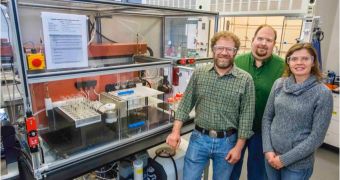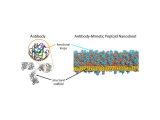Scientists at the US Department of Energy's Lawrence Berkeley National Laboratory announce the development of an antibody-mimetic peptoid nanosheet, a novel material that could set the stage for the development of innovative biosensors inspired by nature.
The molecular “Velcro” mimics the action of antibodies when interacting with pathogens, allowing it to recognize viruses and toxins very fast.
Berkeley Lab investigators say they have taken their cues from the human immune system, and that they were able to apply the principles they derived from their study on a new material, which is just 100 nanometers across.
Preliminary results show that the molecular Velcro is capable of recognizing and differentiating between hundreds of different molecules easily and quickly.
The new material consists of a bi-dimensional nanosheet covered with functional loops. This represents the same architectural design found in antibodies, where the structural scaffold stays roughly the same regardless of the pathogen or compound the antibody attacks.
What changes are the variable functional loops that the antibody uses to bind to foreign substances. The molecular Velcro is a self-assembling structure, derived from bio-inspired, synthetic polymers called peptoids.
The main advantage of these peptoids is that they can easily bend and fold to produce protein-like architectures. As the scaffold self-assembles, researchers add short molecular segments that are pushed out of the material as it bends; this leads to the creation of the Velcro-like structure.
“The advantage here is that we’re able to make these materials in very high yield. We’re borrowing this idea of stringing together a particular sequence of monomers, which Nature uses to build 3D protein structures, and applying it to the world of non-natural materials, to create a really useful material that can assemble itself,” says Berkeley Lab postdoctoral researcher Gloria Olivier, the lead author of the paper.
The director of the Berkeley Lab Molecular Foundry’s Biological Nanostructures Facility, Ron Zuckermann, was the corresponding author of the research, which is detailed in the latest issue of the scientific journal ACS Nano.
The team believes that additional progress in this field will eventually enable scientists to develop overarching rules on how to extend the natural rules of protein folding to the world of synthetic materials, enabling exciting applications and new classes of devices.
“That’s kind of what my whole research program here is about: learning from the richness of chemical sequence information found in biology to create new types of advanced synthetic materials. We’re really just starting to scratch the surface,” Zuckermann concludes.

 14 DAY TRIAL //
14 DAY TRIAL // 
